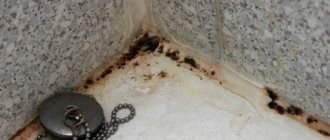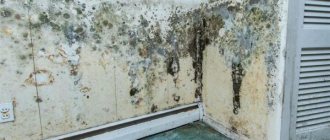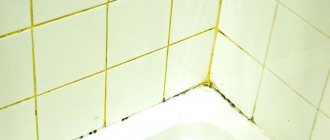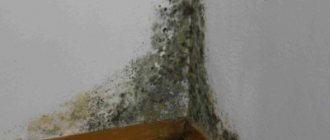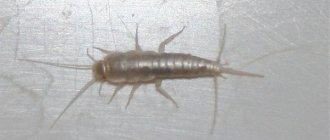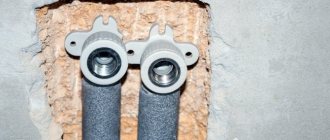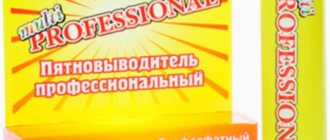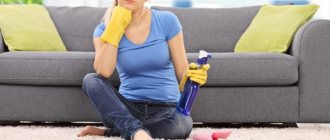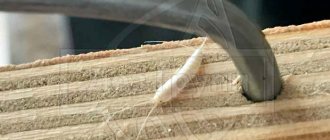High indoor humidity and hot steam, which increases the air temperature, are the main factors affecting the microclimate. If ventilation is impaired or not provided, the process of reproduction of pathogenic particles, including fungal spores, is activated. When choosing a way to get rid of mold in the bathroom, consider home remedies because they are gentle on walls and floors. If traditional methods do not help, deep penetration chemicals are used.
Hot steam affects the microclimate of the room.
Common Types of Mold
This is the name given to filamentous formations that form a single multicellular structure. Mold multiplies quickly, the main manifestations being stains on surfaces. Plaque of organic origin can have a different shade. The most dangerous types of mold:
Chaetomium globosum causes damage to wallpaper, window frames, books, and so on.
- Chaetomium globosum, or biodestructor. Found on coatings and things containing cellulose. Mold affects wallpaper, drywall, window frames, books, paintings, etc. At the initial stage, the fibers are characterized by a white color. Gradually the shade changes to olive with a gray undertone or black. This type of mold is most dangerous for people prone to developing allergies. Provokes the appearance of symptoms of asthma, rhinitis, and respiratory diseases.
- Cladosporium herbarum. Promotes the development of negative reactions in allergy sufferers and people not exposed to pathogenic particles. This type of mold is not always black in color. Colonies may be olive or brown in color. This is a type of mold that destroys various objects. It is found on any things, lining, etc. Other types of mold in this group: Chaetomium, Ulocladium, Aspergillus, etc.
- Blue fungus. Modifies surfaces - they acquire a characteristic color. The fungus develops in conditions of high humidity and affects objects made of coniferous wood. It can be found in private houses, rarely in an apartment.
Why is fungus on walls dangerous?
Not all species pose a threat to human health. For example, the fungus Wallemia from the black mold group is difficult to remove, but does not pose a danger. However, most varieties contribute to the development of allergies (at best). With prolonged contact with fungal spores, more severe complications arise: asthma, chronic bronchitis, skin diseases, pneumonia.
Fungus on the walls can cause various skin diseases.
Against the background of intoxication of the body, nausea, abdominal pain appear, and the functioning of the digestive tract and musculoskeletal system is disrupted. With prolonged contact with the most toxic types of fungi (for example, black mold), liver and lung function deteriorates. In the most severe cases, irreversible tissue changes occur and death is possible. The fungus poses a danger to people with reduced immunity: during the period of recovery from illness, while taking antibiotics, while undergoing chemotherapy.
Under the influence of mold, facing materials on walls, floors, and ceilings are destroyed. In this case, the coating is deformed: it swells, peels off, and its structure is disrupted. As a result, it is necessary to re-repair the premises and remove the finishing layer from the affected surfaces and adjacent areas.
If mold is in the bathroom for a long time, then it is more likely that it will penetrate quite deeply into the structure of the structure.
The longer mold has a destructive effect on a building material, the higher the likelihood that it will penetrate into the structure of the supporting structure to a significant depth.
However, in most cases, it is possible to remove the fungus at the stage of its active development in the plaster layer. If the surface is not cleared of dark organic stains that have appeared in time, partial or complete destruction of the coating will soon occur.
Consequences of mold formation
Mold is not just a cosmetic finishing defect that spoils the appearance of the walls or ceiling in the bathroom; it is an alarming symptom of improper operation of the room’s ventilation system. Without adjusting air circulation, it will not be possible to get rid of the fungus forever, even using expensive means. Some types of fungus are dangerous not only for the appearance of the bathroom, but also for human health, so the consequences of its appearance cannot be underestimated.
Mold at the junction of the bathtub and the wall
Mold formation has the following consequences:
- In conditions of constant dampness, the fungus on the surface of walls, ceilings, silicone-based sealants or furniture spreads in large dark-colored colonies, spoiling the appearance of the finish.
- The fungus, settling in the seams between the tiles, shortens the life of building materials and gradually destroys the concrete base of the walls.
- When exhaled, fungal spores can develop inside a person’s lungs, leading to the development of diseases that are difficult to diagnose and treat. Therefore, fungus in the bathroom on the walls or ceiling is dangerous to the health of household members.
Large formation of fungus and mold on the wall
Sometimes, upon external inspection, it is difficult to notice fungus on the walls or ceiling, since it is skillfully hidden under tiles and other finishing materials. Therefore, professional craftsmen advise carrying out a major renovation of the bathroom every 10-15 years, because only in this way can you assess the condition of the walls under the finishing material, as well as clean the concrete base from mold using a special product and a stiff brush.
Mechanical method of removing fungus
One of the tools you will need to remove fungus mechanically is a spatula.
When black spots appear on the sealant in the joints between tiles in the bathroom or on the walls in living areas, the affected coating must first be removed. Different tools are used for this:
- putty knife;
- steel brush;
- grinding attachment (installed on the drill);
- sharp knife, etc.
To prevent the spread of spores through the air (the main method of contamination of surfaces), the cladding must be treated with water. To do this, it is recommended to use a spray bottle. If you use a sponge or rag, some of the spores will become airborne when the material comes into contact with the surface. When the fungus has already penetrated the structure of wood or concrete, the milling method is used. When the infection is severe, mold is also found on inorganic surfaces. If you plan to fight it yourself, it is important to follow the instructions:
- The surface is moistened with water from a spray bottle.
- They free load-bearing structures from cladding: wallpaper on the walls, whitewash on the ceiling, flooring. This will allow you to get to the mycelium.
- If it turns out that the mold has penetrated deeper into the structure of the material of the supporting structure, remove the layer of plaster. It is necessary to clean the wall down to the rough base - brickwork, concrete.
At the next stage, chemicals are used. However, if the preparatory work (mechanical cleaning) did not provide the required result, special means will not destroy the fungus. It will continue to develop on the adjacent site.
Chemical agents can also be used against fungus.
Black mold:
Causes of appearance Why it is dangerous Methods of elimination Remedies:
- special
- folk
Prevention
Dampness in the bathroom is a fact that cannot be avoided. Under these conditions, fungus appears on surfaces. We'll tell you how to prevent unwanted neighbors and how to get rid of mold in the bathroom if it does appear.
Pixabay
Even a good hood sometimes fails to cope with this problem, especially if the family is large and water flows frequently
Folk remedies against mold
Before the advent of special preparations, home methods were used to remove dark spots from surfaces. Some of them remove mold well, which is why they are still used today. However, in terms of effectiveness, they do not always correspond to ready-made drugs. This is partly due to the fact that they use products that have a simple composition (contain 1 component).
To achieve the required result, in most cases it is recommended to apply the substances several times: from 2 to 5. A single treatment does not help destroy pathogenic particles.
Hydrogen peroxide
Hydrogen peroxide against fungus in the bathroom.
A 3% solution is used, it can be purchased at a pharmacy. The advantages of this tool:
- ease of use;
- no odor;
- the substance leaves no traces;
- peroxide can be applied to coatings made of different materials; it does not destroy their structure, but a weak bleaching effect appears on colored surfaces.
To clean mold, you do not need to dilute the substance with water. Instructions for use:
- The product is applied to the surface where the fungus develops. Moreover, the area of this zone should be larger than the affected area.
- We need to vacate the premises for a few hours. If the lesion is weak, 15-60 minutes is enough. During this period of time the premises cannot be used.
- After a few hours, you can ventilate the room, then remove the mold using a stiff brush.
Boric acid
To clean fungus from surfaces at home, prepare a solution: 1 cup of the drug, 2 liters of water. In this case, it is recommended to first remove external manifestations of mold. The surface is first moistened with water to prevent spores from spreading through the air. Once the dark spots have been removed, a boric acid solution can be applied. To do this, use a rag or a soft sponge.
Using boric acid against fungus in the bathroom.
The product is left on the surface. After it dries, the remaining powder and emerging crystals are cleaned off with paper or another sponge. In this case, you cannot use materials that were used to remove the fungus from the surface, because in this case, infection will occur again.
It is permissible to use a less concentrated solution: 4 liters of water, 1 glass of boric acid. It is used to treat surfaces by spraying with a spray bottle. Borax can be used instead of boric acid. These are different substances that exhibit similar properties. Both are antiseptics, but borax is less effective.
Tea tree oil
Tea tree oil for fungus in the bathroom.
This product helps remove fungus, since microorganisms are sensitive to the components that make up it. It is necessary to prepare a solution: 1 tsp. essential oil, 500 ml water. The substance is sprayed over the affected surface, then the dark coating is removed.
The duration of action of the product is 12 hours. Moreover, you cannot be indoors at this time. There is no need to rinse it off after the solution has finished working.
It is necessary to take into account that the aroma will remain in the room for some time. In case of intensive infection, prepare a more concentrated solution: 20 ml of essential oil, 1 liter of water.
Soda and vinegar
You can use soda ash and baking soda. If mold appears on tiles and other surfaces that can withstand exposure to aggressive substances, it is recommended to prepare a solution:
- Heat water (5 l).
- Add 150 g of soda of any kind. Moreover, the desired chemical reaction will occur provided that the components are diluted with hot water.
- Vinegar essence (9% concentration) - 100 g is poured into the resulting solution.
Killing fungus in the bathroom with baking soda and vinegar.
When mixing the components, foam is formed. After obtaining the desired chemical reaction, you can apply the product to the affected surfaces. To destroy fungus that has spread extensively along the wall/ceiling or floor, you need to carry out repairs - this is a radical method, but thanks to it mold is destroyed forever. First, remove the plaster, then sprinkle the area with soda and spray with concentrated vinegar.
Aqueous ammonia
This product can be applied to coatings that are characterized by the absence of pores, for example, to the joints of ceramic tiles in the bathroom. To improve the properties of aqueous ammonia, glycerin is added. Apply the substance using a rag or sponge. Care must be taken when doing this, as aqueous ammonia is toxic. After treatment, you need to leave the room for 1 hour. Then the remaining product is washed off from the surfaces.
Use of aqueous ammonia.
Copper sulfate
This method is considered the most effective in combating fungus. It is distinguished by a significant impact on pathogenic particles. Prepare a solution using 100 g of copper sulfate (copper sulfate), 10 liters of water. If the affected area is small, the number of components is proportionally reduced. Use a brush for application. It is recommended to treat an area ¼ or 1/3 larger than the area where the fungus is developing. After a few hours, ventilate the room, wash off the solution, and along with it the fungus.
The effectiveness of using copper sulfate against fungus.
Chlorine bleach
Any product containing chlorine can be used. To destroy the fungus, Belizna and Domestos are suitable. A concentrated product is applied to the affected areas. A rag is used for this. Cleaning silicone (tile joints) is carried out with an aqueous solution based on a chlorine-containing agent. The ratio of components is 1:1. Use a spray bottle for spraying.
Chemicals
Living in rooms with fungus is dangerous. Mold spores enter the lungs and onto the skin, causing various diseases. You can fight fungi in different ways.
Abedis 06
Dilute 1:2. A liter of the drug per 2 liters of water. Due to the chlorine in the composition, wear gloves before working. Harmful to health. Use with caution after reading the instructions. Apply with a brush or roller overnight. Afterwards, rinse with water.
Biotol spray
Clean the affected surface before applying biotol. Then use a spray bottle to spray the product onto the areas. If the fungus penetrates deeply, the treatment must be repeated. Biotol is safe. There are no toxic substances in the composition.
Biotol spray – anti-mold agent
Biotsid-S
Dilute the drug with water 1:3. It contains chlorine. Before work, put on gloves and a mask.
The biocide is used in medicine.
It is used to disinfect surfaces.
Dali
The cleaner is applied to any surface: wood, ceramics, concrete, tiles, brick. Versatile, highly effective. Destroys all types of fungus. Has a pungent odor. Before use, wear protective clothing and goggles. Fights algae and moss.
Universal antiseptic Dali against mold and mildew
Mavix-Bio
Domestic manufacturer's drug
Expensive, but effective. Buy with a water repellent. Impregnation is purchased as a kit. Use it to lubricate the affected areas before work. Afterwards, apply Mavix. The validity period is indicated in the instructions. After a few hours, remove the mold. Then treat the areas with a water repellent. This is the final point that protects surfaces from water and dirt.
Folk remedies
Instead of chemicals, you can resort to home remedies.
- Ammonia. Dilute with water 1:1. Apply using a spray bottle. Then wipe with a rag or towel. They will absorb the remaining moisture. If necessary, repeat the procedure. Wait 3-4 hours. Clean and dry the surface with a cloth.
- Borax. Hazardous to health. Wear gloves. But the product does not emit toxic fumes. Pour 2 cups of the substance into a five-liter bucket of water. Treat infected areas, then rinse with water.
- Hydrogen peroxide. Use a three percent solution. Spray with a spray bottle until completely saturated. A toothbrush is also used. After waiting 20 minutes, clean out the mold and rinse with water. Dry with a towel.
- Bleaching. Apply to any surface: tiles, wood, enamel, glass. For 1 part of substance – 10 parts of water. Due to toxic substances, wear gloves, goggles, and a respirator before working. Apply to areas with a spray bottle. Bleach eats away the color. The substance is not suitable for all surfaces.
- Vinegar. Versatile. Fights against any type of mold. Apply by spray. After 15 minutes, the surface is cleaned with a medium-soft brush. Then it is washed off with water. Ventilate the room after work.
At the first appearance of the fungus, you need to get rid of it urgently
Household chemicals
Effective drugs are being developed to kill mold. With their help, you can get rid of pathogenic microflora forever. It is important to study tips on the use of potent drugs, which will help prevent the occurrence of health problems.
Cillit Bang Spray
This is a type of chlorine-containing product. The composition includes a significant amount of chlorine, which increases the effectiveness of the spray. After spraying, this product is left on the surface for 20 minutes. Considering that it is highly toxic, you should not stay indoors at this time. After 20 minutes, the substance is washed off.
Cillit Bang anti-mold spray in the bathroom.
Bagi Anti-mold spray
This is a highly specialized drug used in the fight against fungi and mold. Ingredients: hypochloride <5%, urfactants 5-15% - stabilizers, purified water and perfume. It is recommended to use it to process tiles, plastic, cast iron, and acrylic. The product should not be used on untested surfaces. After application, you need to wait a little, then the substance is washed off with water.
Bagi Anti-mold spray is a highly specialized drug.
Dec spray from Neohim
This is an antibacterial agent, with its help it destroys not only fungi, but also other types of microorganisms. The advantage is its universal action. The substance is used to treat almost any coating. After use, you need to wait a while, then wash off the substance with water.
Dec spray from Neohim is an antibacterial agent.
Prosept Bath Fungi
Belongs to the group of alkaline antibacterial agents and contains chlorine. This drug is available in the form of a spray. It is used to treat surfaces against fungus and bacteria. After spraying, you need to close the room for several hours, or better yet, all night. Then the substance is cleaned from the surface along with the remnants of the fungus.
Prosept Bath Fungi containing chlorine.
Mellerud product from Germany
Under this brand, various products are produced that differ in composition: with chlorine, without this component. Regardless of the type, it is recommended to be careful when working with such substances, as they are toxic. The surfaces are treated with the spray and the substance is removed after 20 minutes. Moreover, it is necessary to use a lot of water to wash off the product.
Mellerud product.
Ways to fight fungus
If mold appears, you need to take measures to remove it. This can be done both with the help of branded antiseptics and folk remedies.
Removal of fungus is carried out as follows:
- First of all, we determine the source of the fungus. The mycelium may be located in a hard-to-reach place, for example, behind tiles or under plumbing fixtures. In this case, plaque on the tile can only be a consequence of a mycelium that is invisible at first glance.
- When the source is detected, we begin to scrape off the mold. Clean the scraped area with a hard-bristled brush. When looking for the source of the problem, it is recommended to tap the tiles to find any voids. Where they exist, you need to remove the tiles and clean them.
- If fungus is found in the grout between the tiles, the entire grout mass is removed.
- We warm up the cleaned areas with a hair dryer or a powerful heater. It is strictly not recommended to use hot water to warm the affected areas. Warming up should only be dry.
- We treat the walls with antiseptic and waterproofing agents.
- We warm up the air in the bathroom well.
Traditional methods
One of the most effective remedies in the folk arsenal is creosote, made from tar. This material has long been used to treat structural materials against rotting. Creosote is a yellow, oily liquid with a strong odor. The material is difficult to dissolve, so to dilute it you will need alcohol.
Note! Creosote emissions are hazardous to health. Therefore, after use, traces of the substance must be removed using household chemicals.
Vinegar is also popular as a fungus killer. We are talking about ordinary white vinegar, which is used in cooking. Vinegar is a product of natural origin and is completely safe for health. The only drawback of this product is the strong smell, which, however, soon disappears.
To remove mold, you need to soak a sponge in vinegar and rub the problem areas with it. After the surface has dried, it must be treated with a brush with stiff bristles. Cleaning is completed by rinsing the surface with warm, clean water.
Another effective remedy is hydrogen peroxide. The solution has a bactericidal effect. The disadvantage of peroxide is that it leaves whitish marks on colored surfaces. Although hydrogen peroxide is non-toxic, a highly concentrated solution (more than 3%) can cause skin burns.
In addition to the above, some other means have also shown effectiveness, including:
- laundry bleach;
- baking soda;
- bleach-based cleaning products;
- ammonia;
- copper sulfate;
- boric acid;
- inkstone;
- tea tree oil.
The most unsafe products include chlorine-containing solutions. To ensure the safety of your skin and respiratory tract, you must use protective gloves and a respirator when using such products.
Professional methods of fungus destruction
For this purpose, concentrated preparations are used, which are highly effective in combating mold and other pathogenic particles. For comparison, if you use folk remedies, you will need to apply the substance many times. Professional methods allow you to destroy the fungus in 1-2 approaches. Such preparations are produced in the form of concentrated liquids. With their help, a solution is prepared or the substance is applied undiluted.
Sanitation and ionization of the room
The purpose of the measures is to destroy mold. To do this, ionized air is used, it is supplied under high pressure towards the affected surfaces. The advantage of this method is the absence of an unpleasant odor. The product is non-toxic; after treatment there is no need to rinse off the substance.
There is a detrimental effect of silver ions on pathogenic particles: fungus, bacteria, etc. The disadvantage of the method is the need to use special equipment, which is expensive. For this reason, it is necessary to invite specialists to process the housing.
Method 1 – Bleach Solution
This is the most affordable way to remove fungus from surfaces. Apply it like this:
- First, prepare a bleach solution for further surface treatment. To do this, mix any bleach (ordinary “Whiteness” will do) with water in a ratio of 1:10.
- Using a mop, rag or sprayer, apply this product to all surfaces.
- Ventilate the room so that there is no unpleasant odor left in it.
Video: how to remove fungus using whitening?
Important:
There is no need to wash off the bleach solution from surfaces. On the contrary, it is best to leave it there so that it prevents further mycelium formation.
You need to be extremely careful when working with such a product, especially a chlorine-based solution. It is recommended to carefully ensure that it does not get on the mucous membrane, otherwise it can cause severe chemical burns.
Safety rules when processing premises
When treating a room for mold, a respirator is required for safety reasons.
When carrying out mold removal work, it is necessary to ensure protection of the outer coverings:
- use a respirator to prevent fungal spores from entering the respiratory tract and avoid poisoning by chemical vapors;
- you need to work with gloves;
- If spray is used, safety glasses should be worn.
After finishing the treatment, it is recommended to throw away the used products. The room also needs to be prepared: small items (bottles, hygiene products, etc.) are taken out. Furniture and other large items can be left, but they should be covered with plastic. After application of the product is completed, the room is closed for 1-12 hours. Once the substance has been removed from the surfaces, it is better not to enter the room for several days.
Instructions for getting rid of fungus from the bathroom
Removing mold is a rather difficult and lengthy process that takes place in several important stages:
- It is necessary to remove places where moisture originates, such as leaking taps, pipes or toilets. They are repaired and brought to full tightness.
- All plastered or painted surfaces that are moldy are removed by deep cleaning. Although it is difficult, this procedure must be carried out.
- Then it is necessary to thoroughly dry all treated areas with heaters, even those that were not exposed to mold.
- After drying, treat with any special antifungal agent, paying special attention to favorite places where fungus appears.
- The main element for protection against mold is moisture insulation of the room, so when painting, use moisture-resistant paint.
- Pay special attention to bathroom ventilation. The constant presence of fresh air will protect the room from the appearance and proliferation of fungus.
Read here: How to bleach plastic - effective ways to bleach yellowed plastic at home (90 photos)
How to prevent mold
It is recommended to maintain acceptable indoor conditions: minimize humidity levels and control air temperature. However, mold can develop when all indicators are normal: the temperature is +20°C, the humidity level is 30%. For this reason, in order to avoid the development of fungus, it is necessary to increase the efficiency of the ventilation system - you need to install a fan, which will increase air circulation. While drying clothes and after water procedures, do not close the doors to the bathroom. The same conditions must be met in the kitchen.
Causes of fungus in the bathroom
The following factors can contribute to the appearance of mold in the bathroom:
Read here: Paste - detailed instructions on how to cook a high-quality composition at home (85 photos)
High room humidity. Fungal spores multiply at humidity above 30% and the bathroom is ideal for mold growth. Flowing pipes and the formation of water droplets on them also contribute to their reproduction.
Little natural light. In most cases, bathrooms do not have windows and for this reason sunlight does not enter here, which fungal spores cannot tolerate. And artificial light does not have a noticeable effect on the development and growth of mold.
High temperature conditions. Bathrooms are almost always kept at a high temperature. This is due to the presence of hot pipes, frequent use of hot water and a running towel dryer. And the absence of windows and low temperatures have a beneficial effect on the appearance of mold.
There is not enough air ventilation. There are many difficult-to-reach places in the bathroom where fresh air does not flow, and if there is insufficient ventilation, mold appears there first.
Lots of shaded areas for easy access. It is in such secluded places that mold first begins to multiply unnoticed and subsequently spreads to open spaces. They can be places: under the bathtub, behind the washing machine, sink, toilet, etc.
